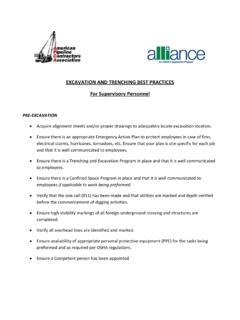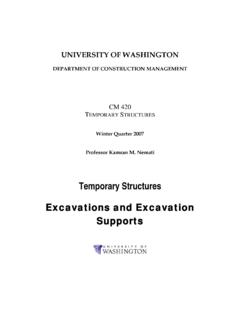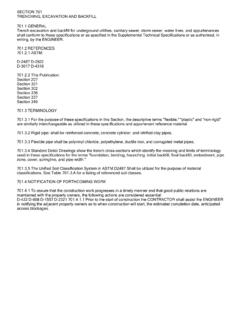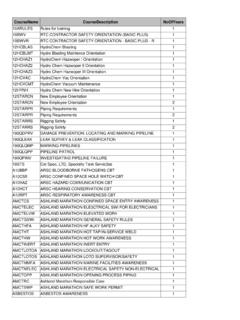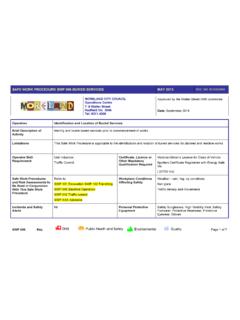Transcription of DEPARTMENT OF LICENSING AND REGULATORY …
1 1 MIOSHA-STD-1306 (10/15) 16 Pages For further information Ph: 517-284-7740 DEPARTMENT OF LICENSING AND REGULATORY AFFAIRS DIRECTOR'S OFFICE CONSTRUCTION SAFETY STANDARDS Filed with the Secretary of State on August 17, 1979 (as amended November 23, 1982) (as amended January 11, 1988) (as amended July 8, 1993) (as amended September 3, 1996) (as amended March 14, 2013) These rules become effective immediately upon filing with the Secretary of State unless adopted under section 33, 44, or 45a(6) of 1969 PA 306. Rules adopted under these sections become effective 7 days after filing with the Secretary of State. (By authority conferred on the director of the DEPARTMENT of LICENSING and REGULATORY affairs by sections 19 and 21 of 1974 PA 154, and Executive Reorganization Order Nos.)
2 1996-2, 2003-1, 2008-4, and 2011-4, MCL , , , and ) R , R , R , and R of the Michigan Administrative Code are amended and R and R are rescinded, as follows: PART 9. EXCAVATION, TRENCHING, AND SHORING TABLE OF CONTENTS R Scope.. 1 R Definitions A to Q.. 1 R Definitions; S.. 2 R Definitions; T, U.. 2 R Locating utility lines.. 2 R Excavation; consideration of soil types; water; slide hazards.. 2 R Excavation; obstructions; retaining materials; egress; guarding; heavy equipment.. 3 R Hazardous atmospheres; testing and controls.. 3 R Excavation; angle of repose.. 3 R Supporting systems; angle of repose; tie backs; tight sheeting; additional bracing.
3 4 R Additional requirements for trench support systems .. 4 R Benching and sloping.. 5 R Trenching boxes and shields.. 5 R Walkways, sidewalks, roadways.. 5 R Adjacent structures; protection; design; inspection of shoring, bracing, and underpinning.. 5 Appendix .. 6 R Scope. Rule 901. This part pertains to the digging of excavations and trenches which an employee is required to enter and the supporting systems used on construction operations. R Definitions A to Q. Rule 925. (1) Angle of repose means the maximum permissible slope as determined by table 1. (2) Braces or struts means the horizontal cross members of a shoring system that bear against the uprights or stringers.
4 (3) Excavation means any man-made cavity or depression in the earth s surface, including its sides, walls, or faces, formed by earth removal. For the purpose of this part, a trench is an excavation. (4) Hazardous atmosphere means an atmosphere which, by reason of being any of the following, may cause death, illness, or injury: (a) Explosive. (b) Flammable. (c) Poisonous. (d) Corrosive. (e) Irritating. (f) Oxygen deficient. (g) Toxic. (h) Otherwise harmful. (5) Kickouts means the accidental release or failure of a stringer or brace. (6) Qualified person means a person who, by possession of a recognized degree or certificate of professional standing, or who, by extensive knowledge, training, and experience, has successfully demonstrated the ability to solve or resolve problems relating to the subject matter and work.
5 2 R Definitions; S. Rule 926. (1) Sheet piling means a continuous row of timber or steel piles driven in close contact to provide a tight wall to resist lateral pressure of water, adjacent earth, or other materials. (2) Sides, sometimes called faces or walls, means the vertical or inclined earth surfaces formed as a result of excavation work. (3) Slope means the acute angle formed by the side of a trench or excavation and the horizontal plane. (4) Soil means any of the following: (a) Clay a very fine textured soil that derives its resistance to displacement from cohesion and may be: (i) Soft clay a clay-type soil that has an unconfined strength of less than ton per square foot.
6 (ii) Medium clay, sometimes called plastic a clay-type soil that has a minimum unconfined strength of ton per square foot. (iii) Firm soil a clay-type soil that is resistant to forces causing rupture or displacement. A firm clay has a minimum unconfined strength of tons per square foot. (iv) Stiff clay a clay-type soil that is very resistant to forces causing rupture or displacement. A stiff clay has a minimum unconfined strength of tons per square foot. (b) Fill a manmade soil condition that may be constructed of any type of soil or combination thereof. (c) Granular soil a course grained soil that does not possess cohesion but derives its strength from internal friction.
7 (d) Organic soil A soil that contains significant amounts of peat, muck, or marl. (e) Running soil any type of soil that has insufficient strength to stand unsupported. Running soil tends to run or slough into the excavation as the excavation is being dug. (5) Stringers means the horizontal members of a trench shoring system whose sides bear against the uprights or earth. (6) Supporting system means the total system necessary to restrain the sides of an excavation from moving. R Definitions; T, U. Rule 927. (1) Tight sheeting means a continuous row of wood or steel sheets in close contact to provide a tight wall, but is not driven as with piling.
8 (2) Toe of slope means the point at which the side of an excavation intersects the lowest level of the excavation. (3) Trench means an excavation having a depth greater than its width measured at the bottom. (4) Trench jack, means a screw or hydraulic jack used as a brace in a trench shoring system. (5) Trench shield sometimes called a trench box, means a trench shoring system composed of steel plates and bracing, welded or bolted together, which can be moved along as work progresses. (6) Uprights means the vertical members of a trench shoring system. R Locating utility lines. Rule 931. (1) An employer shall not excavate in a street, highway, public place, a private easement of a public utility, or near the location of a public utility facility owned, maintained, or installed on a customer s premises, without having first ascertained the location of all underground facilities of a public utility in the proposed area of excavation.
9 (2) Upon receiving the information from the public utility, an employer shall exercise reasonable care when working in close proximity to the underground facilities of any public utility. If the facilities are to be exposed, or are likely to be exposed, only hand digging shall be employed in such circumstances and such support, as may be reasonably necessary for protection of the facilities, shall be provided in and near the construction area. (3) When any contact with, or damage to, any pipe, cable, or its protective coating, or any other underground facility of a public utility occurs, the public utility shall be notified immediately by the employer responsible for operations causing the damage.
10 If an energized electrical cable is severed, an energized conductor is exposed, or dangerous fluids or gasses are escaping from a broken line, the employer shall evacuate the employees from the immediate area while awaiting the arrival of the public utility personnel. R Excavation; consideration of soil types; water; slide hazards. Rule 932. (1) If different textured soils are encountered in the side of an excavation, each soil type of the excavation shall be cut to the proper angle of repose, except that the slope shall not steepen between the toe of the slope and the ground level where soft clay or running soil is encountered in the lower cut.










